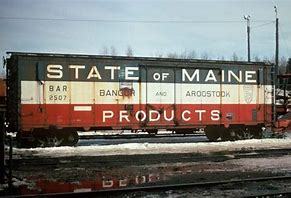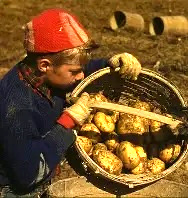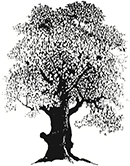MAINE-LY GARDENING: What’s in the Garden? Potatoes – Part 2

 by Jude Hsiang
by Jude Hsiang
 When Joseph Houlton arrived in Aroostook County in 1807, he brought along a variety of potato called Early Blue. Only a few decades later the potato had become an important crop with Maine producing 10 million bushels a year by the 1940s.
When Joseph Houlton arrived in Aroostook County in 1807, he brought along a variety of potato called Early Blue. Only a few decades later the potato had become an important crop with Maine producing 10 million bushels a year by the 1940s.
In addition to the potatoes, Aroostook land provided the cedar, elm, and ash used to make the barrels that were used to harvest the crop: 12-peck barrels held 165 pounds. For decades schoolchildren helped with the harvest. As a little girl in southwestern Maine, I was jealous of my “big boy” cousins in Presque Isle who started school early, then joined the three week “Harvest Break” to earn money on the potato harvest. This tradition remains despite the mechanization of the harvest that continues to advance.
Many of us remember the excitement and pride when traveling far beyond Maine and spotting one of the blue, white, and red Bangor and Aroostook Railway cars whose sides proudly proclaimed, “State of Maine Products.”
Even though Maine’s share of the worldwide potato market has decreased it is still an important art of the state’s economy. In addition to producing potatoes for our tables, Maine provides seed potatoes for the U.S. east coast. Potato starch has always been a key product, and the recent increase in interest in gluten-free foods has in turn increased its use for home cooks, restaurants and prepared food items. Almost one half of Maine’s potatoes are used for French fries and another 20 percent for potato chips.
It’s difficult to imagine what the diet of Europeans and later North Americans was like before the introduction of the potato. Bread was their everyday source of starch, and although they grew wheat, oats, rye, and barley, for many people those grains can’t compare to the wide array of recipes for potatoes. There are hundreds of dishes that use this staple food, and cooks continue to come up with more variations.
One more family story. After the attack on Pearl Harbor in 1941, my father enlisted in the U.S. Army along with many thousands of young men. He was part of a contingent sent from Maine to Mississippi for basic training. During that period the mess hall served grits for breakfast and rice for lunch and supper. Dad recalled the glum faces of “the Maine boys” when lining up for yet another meal with no potatoes.
Enjoy the freedom to choose your favorite potato dish, grown in your own central Maine garden, or upcountry.
© Judith Chute Hsiang
Jude Hsiang Is a retired Extension Master Gardener instructor and member of the China Community Garden.
Responsible journalism is hard work!
It is also expensive!
If you enjoy reading The Town Line and the good news we bring you each week, would you consider a donation to help us continue the work we’re doing?
The Town Line is a 501(c)(3) nonprofit private foundation, and all donations are tax deductible under the Internal Revenue Service code.
To help, please visit our online donation page or mail a check payable to The Town Line, PO Box 89, South China, ME 04358. Your contribution is appreciated!


Leave a Reply
Want to join the discussion?Feel free to contribute!